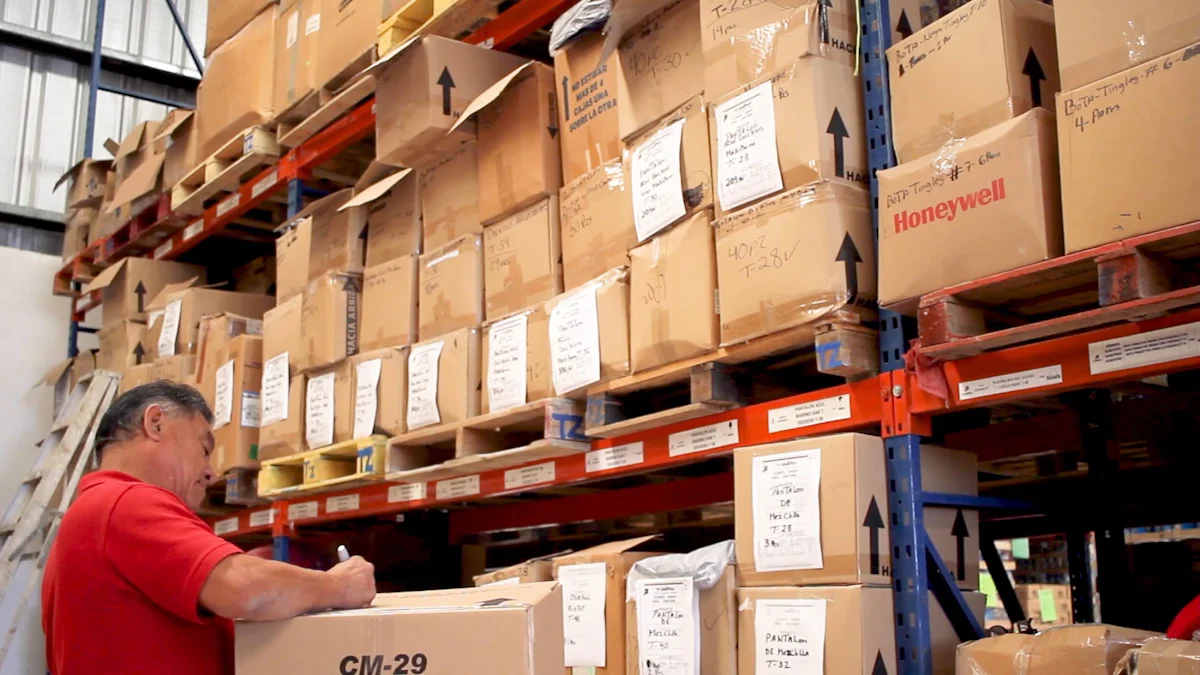How to standardized warehouse management for manufacturing in India

Warehouse management plays a crucial role in the manufacturing sector, ensuring seamless operations and efficient supply chain management. In India, the warehousing industry remains in its early stages compared to Western counterparts. Despite abundant labor, the industry grapples with challenges such as inadequate infrastructure and insufficient skilled personnel. These issues highlight the urgent need for standardization in warehouse operations. By adopting standardized practices, Indian manufacturers can enhance operational efficiency, reduce costs, and improve overall productivity, paving the way for a more robust and competitive manufacturing landscape.
Understanding Warehouse Management
Warehouse management serves as the backbone of manufacturing operations. It involves the systematic control and oversight of various processes within a warehouse, ensuring that goods move efficiently from receipt to dispatch. This section delves into the definition, key components, and the pivotal role of warehouse management strategies in manufacturing.
Definition and Key Components
Warehouse management encompasses several critical components that work together to optimize operations.
Inventory Management
Inventory management involves tracking and controlling stock levels to meet production demands without overstocking. Efficient inventory management minimizes holding costs and reduces the risk of stockouts. Technologies like Real-Time Locating Systems and Radio-Frequency Identification (RFID) have become essential tools. They provide accurate data on inventory levels, helping warehouse operators maintain optimal stock levels and streamline operations.
Order Fulfillment
Order fulfillment refers to the complete process from receiving an order to delivering it to the customer. It includes picking, packing, and shipping. A well-managed order fulfillment process ensures timely delivery and enhances customer satisfaction. Automation and Warehouse Management Systems play a crucial role here by optimizing picking paths and reducing errors, thereby increasing efficiency.
Storage Solutions
Storage solutions involve the strategic placement of goods within a warehouse to maximize space utilization and accessibility. Intelligent storage allocation and optimized picking paths minimize travel time and enhance resource utilization. Automated storage and retrieval systems further improve efficiency by reducing manual handling and increasing accuracy.
Role in Manufacturing
Warehouse management significantly impacts manufacturing processes, influencing production efficiency, cost reduction, and quality control.
Impact on Production Efficiency
Efficient warehouse management directly affects production efficiency. By ensuring that materials and components are readily available, it minimizes production delays. Technologies like robotic systems automate material handling and sorting, reducing labor costs and improving productivity. This seamless integration of warehouse operations with manufacturing processes enhances overall efficiency.
Cost Reduction
Effective warehouse management contributes to cost reduction in several ways. By optimizing inventory levels, it reduces holding costs and minimizes waste. Automation eliminates manual errors and inefficiencies, leading to smoother operations and lower labor costs. Implementing a WMS provides a more accurate snapshot of warehouse activities, reducing the need for continuous audits and saving time.
Quality Control
Quality control in manufacturing relies heavily on efficient warehouse management. Proper storage solutions prevent damage to materials and ensure that only high-quality components reach the production line. By maintaining accurate inventory records, warehouse management supports stringent quality checks, ensuring that products meet industry standards.
Challenges in Indian Manufacturing Warehouses
Infrastructure Limitations
Space Constraints
Indian manufacturing warehouses often face significant space constraints. Many facilities operate in densely populated urban areas where land is scarce and expensive. This limitation restricts the ability to expand storage capacity, leading to overcrowded warehouses. Overcrowding can result in inefficient operations, as workers struggle to navigate through cramped spaces. To address this, some companies are exploring vertical storage solutions and optimizing existing layouts to maximize available space.
Technological Gaps
Technological advancement in Indian warehouses lags behind global standards. Many facilities still rely on manual processes, which can lead to errors and inefficiencies. The lack of advanced technology, such as automated storage and retrieval systems, hampers productivity. However, leading businesses in India are beginning to automate their warehouse networks. Automation not only improves service levels but also reduces costs, driving growth in the industry. Embracing technology will be crucial for Indian warehouses to compete on a global scale.
Workforce Management
Skill Development
The abundance of labor in India presents both an opportunity and a challenge. While there is no shortage of workers, the training mechanisms in place are often inadequate. Many workers lack the necessary skills to operate advanced machinery or manage inventory efficiently. Investing in skill development programs is essential. By providing comprehensive training, companies can enhance workforce capabilities, leading to more efficient warehouse operations.
Labor Regulations
Labor regulations in India can pose challenges for warehouse management. Complex and often rigid labor laws can make it difficult for companies to adapt to changing business needs. Navigating these regulations requires careful planning and compliance. Companies must stay informed about legal requirements and work closely with regulatory bodies to ensure adherence. By doing so, they can avoid potential legal issues and maintain smooth operations.
Benefits of Standardizing Warehouse Management

Improved Efficiency
Standardizing warehouse management significantly enhances operational efficiency. By implementing streamlined processes, companies can optimize their workflows and reduce unnecessary steps. This leads to faster operations and improved productivity.
Streamlined Processes
Warehouse operations benefit greatly from streamlined processes. Companies can achieve this by adopting automation and Warehouse Management Systems (WMS). These technologies help in organizing tasks, reducing manual interventions, and ensuring that operations run smoothly. For instance, robotic systems automate material handling and sorting, which minimizes human error and accelerates the movement of goods within the warehouse.
Reduced Errors
Standardization plays a crucial role in minimizing errors. By establishing clear guidelines and procedures, warehouses can ensure consistency in operations. Technologies like Radio-Frequency Identification (RFID) and Real-Time Locating Systems provide accurate data, reducing the chances of mistakes. This accuracy not only saves time but also reduces costs associated with rectifying errors.
Enhanced Customer Satisfaction
Standardized warehouse management directly impacts customer satisfaction. Efficient operations lead to faster delivery times and accurate order fulfillment, which are critical factors in meeting customer expectations.
Faster Delivery Times
Customers value prompt delivery. By standardizing processes, warehouses can ensure that orders are processed and dispatched quickly. Automation and optimized picking paths contribute to reducing the time taken from order receipt to shipment. This efficiency translates into shorter delivery times, enhancing the overall customer experience.
Accurate Order Fulfillment
Accuracy in order fulfillment is paramount for customer satisfaction. Standardized procedures ensure that the right products are picked, packed, and shipped to the correct destinations. Implementing best practices and utilizing technology like WMS helps in maintaining high accuracy levels. This reduces the likelihood of returns and increases customer trust in the company's reliability.
Steps to Standardize Warehouse Management

Implementing Best Practices
Lean Warehousing
Lean warehousing focuses on eliminating waste and optimizing processes within the warehouse. Companies can achieve this by identifying non-value-added activities and streamlining operations. For instance, reducing unnecessary movement of goods and optimizing storage layouts can significantly enhance efficiency. Lean principles encourage continuous improvement, ensuring that warehouses operate at peak performance. By adopting lean warehousing, companies can reduce costs and improve service levels, making their operations more competitive.
Automation and Technology Integration
Automation plays a pivotal role in standardizing warehouse management. Integrating technology such as automated storage and retrieval systems (AS/RS) and robotics can transform warehouse operations. These technologies minimize manual handling, reducing errors and increasing speed. A Warehouse Management System (WMS) provides real-time visibility into inventory levels, optimizing storage space and improving inventory control. As an expert in Warehouse Management Systems states:
"A Warehouse Management System (WMS) can help companies manage their inventory levels effectively, track product movement, and optimize warehouse operations."
By leveraging automation and technology, warehouses can achieve higher accuracy and efficiency, leading to improved customer satisfaction.
Training and Development
Employee Training Programs
Training programs are essential for equipping employees with the skills needed to operate advanced warehouse technologies. Comprehensive training ensures that staff understand standardized procedures and can perform tasks efficiently. Companies should invest in regular training sessions to keep employees updated on the latest industry practices and technologies. Well-trained employees contribute to smoother operations and reduced error rates, enhancing overall warehouse performance.
Continuous Improvement Initiatives
Continuous improvement initiatives foster a culture of innovation and excellence within the warehouse. Encouraging employees to identify areas for improvement and suggest solutions can lead to significant operational enhancements. Regular feedback sessions and performance reviews help in assessing the effectiveness of current practices and identifying opportunities for growth. By embracing continuous improvement, companies can maintain high standards and adapt to changing market demands, ensuring long-term success in warehouse management.
Case Studies and Examples
Successful Implementations in India
JUSDA Case Study
JUSDA, a prominent player in the supply chain technology management sector, has set a benchmark in warehouse management standardization. They have successfully integrated advanced technologies and best practices to streamline operations across their extensive network. JUSDA's approach involves the establishment of a "Warehouse Technical Committee" that focuses on talent cultivation, standard setting, and technology promotion. This committee has been instrumental in addressing inefficiencies and fostering a culture of continuous improvement.
JUSDA's implementation of automated systems and real-time data analytics has significantly enhanced their operational efficiency. By leveraging these technologies, they have reduced manual errors and improved inventory accuracy. Their commitment to standardization has not only optimized their internal processes but also set a precedent for other companies in the industry.

JUSDA Solutions
To provide you with professional solutions and quotations.
Lessons Learned
Key Takeaways
Embrace Technology: Successful warehouse management requires the integration of advanced technologies like Warehouse Management Systems (WMS) and automated storage solutions. These tools enhance accuracy and efficiency, leading to improved customer satisfaction.
Continuous Improvement: Establishing a culture of continuous improvement is crucial. Encouraging employees to identify inefficiencies and propose solutions can lead to significant operational enhancements.
Standardization: Implementing standardized procedures ensures consistency in operations. This reduces errors and enhances productivity, ultimately contributing to cost reduction and improved service levels.
Training and Development: Investing in employee training programs equips staff with the necessary skills to operate advanced technologies and adhere to standardized procedures. Well-trained employees are essential for maintaining high operational standards.
By examining these case studies and lessons learned, Indian manufacturers can gain valuable insights into the benefits of standardizing warehouse management. Embracing these practices will not only enhance operational efficiency but also position them competitively in the global market.
Standardizing warehouse management in Indian manufacturing holds immense importance. It enhances operational efficiency, reduces costs, and boosts productivity. The future of warehouse management in India looks promising with the adoption of technologies like Warehouse Management Systems (WMS) and robotic systems. These innovations optimize inventory, improve order fulfillment, and enhance overall efficiency. Industry stakeholders must embrace these advancements to remain competitive. By investing in technology and training, they can transform warehouse operations into more productive, secure, and profitable endeavors.
See Also
Efficiently Maneuvering High-Tech Manufacturing Logistics for Success
Enhancing Efficiency: Understanding Robotic Automation in Warehousing
Logistics Robotics Empowerment: Boosting Warehouse Efficiency
Simplified Strategies for High-Tech Manufacturing Supply Chain Challenges
Automated Tomorrow: High-Tech Manufacturing Warehouse Advantages
